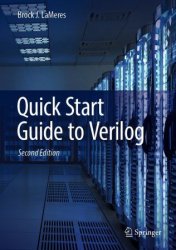 Название: Quick Start Guide to Verilog (2nd Edition) Название: Quick Start Guide to Verilog (2nd Edition)
Автор: Brock J. LaMeres
Издательство: Springer
Год: 2024
Страниц: 244
Язык: английский
Формат: pdf (true)
Размер: 18.5 MB
This textbook provides a starter’s guide to Verilog, to be used in conjunction with a one-semester course in Digital Systems Design, or on its own for readers who only need an introduction to the language. This book is designed to match the way the material is actually taught in the classroom. Topics are presented in a manner which builds foundational knowledge before moving onto advanced topics. The author has designed the presentation with learning goals and assessment at its core. Each section addresses a specific learning outcome that the student should be able to “do” after its completion. The concept checks and exercise problems provide a rich set of assessment tools to measure student performance on each outcome.
The classical digital design approach (i.e., manual synthesis and minimization of logic) quickly becomes impractical as systems become more complex. This is the motivation for the modern digital design flow, which uses hardware description languages (HDL) and computer-aided synthesis/minimization to create the final circuitry. The purpose of this book is to provide a quick start guide to the Verilog language, which is one of the two most common languages used to describe logic in the modern digital design flow. This book is intended for anyone that has already learned the classical digital design approach and is ready to begin learning HDL-based design. This book is also suitable for practicing engineers that already know Verilog and need quick reference for syntax and examples of common circuits. This book assumes that the reader already understands digital logic (i.e., binary numbers, combinational and sequential logic design, finite state machines, memory, and binary arithmetic basics).
Since this book is designed to accommodate a designer that is new to Verilog, the language is presented in a manner that builds foundational knowledge first before moving into more complex topics. As such, Chaps. 1-6 provide a comprehensive explanation of the basic functionality in Verilog to model combinational and sequential logic. Chapters 7-12 focus on examples of common digital systems such as finite state machines, memory, arithmetic, and computers. For a reader that is using the book as a reference guide, it may be more practical to pull examples from Chaps. 7-12 as they use the full functionality of the language as it is assumed the reader has gained an understanding of it in Chaps. 1-6. For a Verilog novice, understanding the history and fundamentals of the language will help form a comprehensive understanding of the language; thus, it is recommended that the early chapters are covered in the sequence they are written.
The second edition of this book adds a chapter on floating-point systems. This new chapter provides a comprehensive background on the IEEE 754 standard for encoding floating-point numbers and then shows Verilog modeling approaches to implement floating-point arithmetic.
Скачать Quick Start Guide to Verilog (2nd Edition)
|